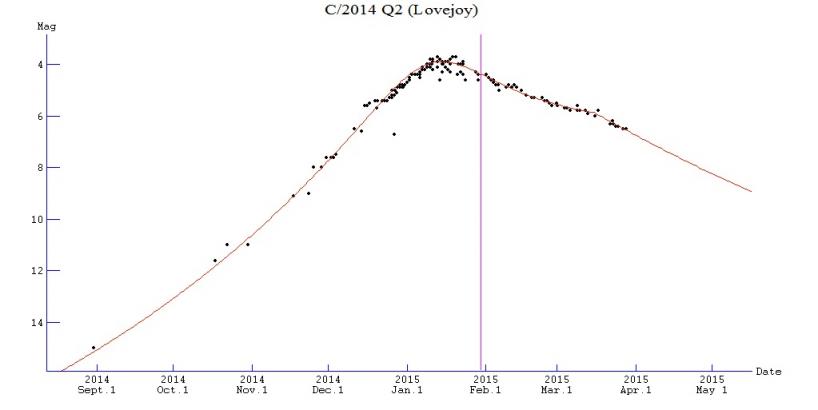ALPO COMET SECTION NEWS FOR APRIL 2015
2015-April-01
Easter occurs in April this year. So it is fitting that one of our brighter comets is doing an Energizer bunny impersonation. It just keeps going and going and going… C/2014 Q2 (Lovejoy) remains the brightest comet in the sky. Though it is 2+ months past perihelion it has only faded from ~4th to ~6th magnitude. Two other comets, 88P/Howell and C/2015 F3 (SWAN), are also bright enough for small aperture observers.
Special thanks to the observers who submitted comet magnitude estimates during March of comets C/2014 Q2 (Lovejoy) and 88P/Howell: Salvador Aguirre (18 estimates), Carl Hergenrother (6) and John D. Sabia (4); and CCD images of C/2013 A1 (Siding Spring) and Lovejoy: Gianluca Masi and Frank Melillo.
Evening Comets (actually both are circumpolar)
C/2014 Q2 (Lovejoy) [Perihelion on 2015-Jan-30 at 1.29 AU from the Sun]
As mentioned above, Lovejoy has remained bright even with increasing heliocentric and geocentric distances. We knew at some point the comet’s fading trend would quicken and recent observations from the past 2 weeks do show a more rapid rate of fading. At the start of April, the comet is around magnitude 6.5 and if its current rate of fading continues it will be a tad fainter than magnitude 8.0 by the end of the month. It will move away from the Sun (1.58 to 1.85 AU) and Earth (1.78 to 2.08 AU) this month as its passes through the circumpolar sky in Cassiopeia.
The plot below shows a lightcurve of C/2014 Q2 produced from visual and CCD magnitude measurements submitted to the Section.
Recent ALPO images and observations of C/2014 Q2 (Lovejoy) can be found in the Comet Section Image Gallery and Magnitude Database. Finder charts can be found at the ALPO Comet Finder Chart page.
C/2015 F3 (SWAN) [Perihelion on 2015-Mar-09 at 0.83 AU from the Sun]
Comet SWAN is the second comet in 2015 to be discovered with the SWAN Lyman-α instrument on the SOHO spacecraft. Robert Matson (Newport Coast, CA, USA) first noticed the comet on SWAN data taken on March 5. V. Bezugly (Dnepropetrovsk, Ukraine) also made an independent discovery. Comet SWAN appeared to rapidly brighten in the SWAN data as it passed through its March 9th perihelion at 0.83 AU. By March 24th, ground-based observers were able to pick up the comet as it rapidly moved out of the Sun’s glare in the evening sky. The most recent observations show SWAN to be around magnitude 10.0. It is a dynamically old comet with an orbital period ~1200 years.
SWAN is racing towards the north as travels through Cassiopeia (Apr 1-13) and Cepheus (Apr 13-30). It passes within 4 degrees of the north celestial pole at the end of the month. There isn’t much photometry for this comet so its brightness trend is still uncertain but the comet should fade from 10th to 11th magnitude as its moves away from the Sun (0.93 to 1.26 AU) but closer to Earth (1.23 AU to 1.05 AU).
Morning Comets
88P/Howell [Perihelion on 2015-Apr-06 at 1.36 AU from the Sun]
Comet Howell reaches perihelion this month at a distance of 1.36 AU from the Sun. Recent observations place Howell at magnitude 9.5 to 10.0. The comet can be seen in the morning sky as it moves through Capricornus (Apr 1-6) and Aquarius (Apr 6-30).
Recent ALPO images and observations of 88P/Howell can be found in the Comet Section Image Gallery and Magnitude Database. Finder charts can be found at the ALPO Comet Finder Chart page.
New Discoveries
Since the last update 4 new comets have been discovered.
P/2015 D6 (Lemmon-PANSTARRS) is a short-period comet with an orbital period of 19.6 years and perihelion distance of 4.55 AU. The comet was detected by the 1.8-m Pan-STARRS1 telescope on March 16 at 21st magnitude. Single night observations by Richard Kowalski with the 1.5-m Mount Lemmon telescope were found from February 27. Perihelion occurs on July 7 of this year. The comet will not get much brighter.
P/2015 F1 (PANSTARRS) is another short-period Pan-STARRS1 discovery having been first detected on March 21 at 19th magnitude. The comet’s current orbit is more asteroidal than cometary and suggests that C/2015 F1 is another example of a Main Belt Comet or Activated Asteroid. With a perihelion of 2.54 AU and aphelion of 4.46 AU, the comet does not leave the Main Belt. It reaches perihelion on March 20 and should not get much brighter than its current 18th magnitude.
P/2015 F2 (Polonia) was discovered by Rafal Reszelewski (Swidwin, Poland), Michal Kusiak (Zywiec, Poland), Marcin Gedek (Oborniki, Poland) and Michal Zolnowski (Krakow, Poland) on Mar. 23 UT with a remote-controlled 0.1-m f/5 astrograph of the Polonia Observatory at San Pedro de Atacama, Chile as part of a dedicated comet-search program. At discovery, Comet Polonia (the first of that name) was 16th magnitude. With an orbital period of 49 years, it is a member of the Halley family of comets. Perihelion occurs on April 29 at 1.20 AU from the Sun. The comet is intrinsically faint and may not get much brighter with the caveat that dynamically old comets like Polonia have a tendency to brighten rapidly. It is definitely one to keep an eye on.
C/2015 F3 (SWAN) was discussed above.
As always, the Comet Section is happy to receive all comet observations, whether images, drawings or magnitude estimates.
- Carl Hergenrother (ALPO Comet Section Coordinator)




